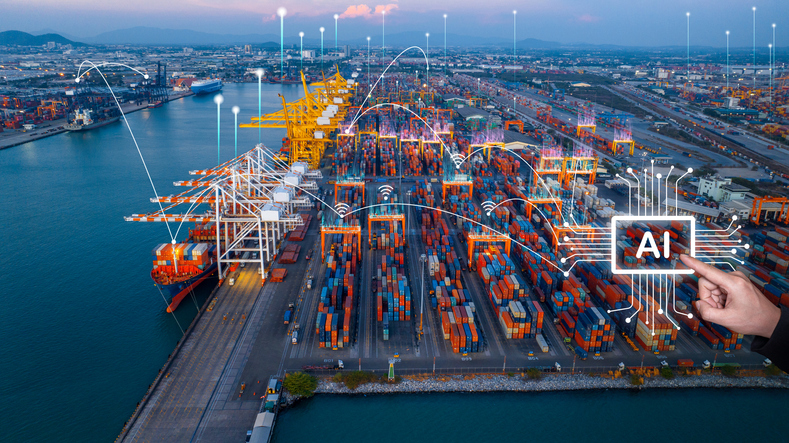AI Isn’t a ‘Silver Bullet’ But Can Still Be a Game Changer

Today’s supply management organizations want to be as close to their customers as possible, reduce their carbon footprints, secure supply and increase productivity, among other priorities. Many see artificial intelligence (AI) as a tool to help them achieve such goals.
But while part of supply management’s future, the use of AI faces several challenges to adoption, speakers at Supply Chain USA 2024 last month in Atlanta. The conference was presented by Reuters Events, part of London-based Reuters News & Media Ltd.
AI Should Be Fundamental
AI and other advanced technologies “are going to be groundbreaking, for not just our business, but for employees,” said Becky Crane, vice president of manufacturing and engineering at General Mills.
“This isn’t something you can do that is extra; it should be fundamental,” said Crane, one of the panelists in the “Decrypt the Future: The Next Chapter for Supply Chains” session. Not only can AI and advanced technology be an aid to employees and help them make an impact, but it can also help them grow their careers, she said.
Arpit Davé, vice president, head of enterprise AI at Amgen, said he’s “a firm believer that science and technology are converging and will continue to converge.” He has seen greater use of AI technologies across the business in such areas as drug discovery and manufacturing as well as the supply chain, he said, adding, “At the end of the day, this technology allows us to bring drugs to patients and doctors, and allows us to reach patients faster.”
Chevron is using the Microsoft CoPilot AI system to drive efficiency, said panelist Steve Freeman, the company’s chief supply chain officer. AI also can aid in research and to automate source-to-pay, he said.
Still, while many organizations are thinking about AI, they often struggle with its applicability, said Patrick Van Hull, industry principal at software provider Interos. And implementing AI can be overwhelming. “Sometimes it comes back to checking the box — what are the minimum requirements?” he said. “How do we ground ourselves, whether it’s regulatory or compliance? Sometimes, we have to start small and build up momentum, because if we’re trying to get there in one step, we’re just not there yet.”
Use Case Basis
Other organizations consider AI a miracle worker. “People look at AI as something you can just drop and it solves all your problems,” said Scott Donahue, vice president of digital transformation at Walmart, during a session on generative AI. But it’s not a “silver bullet,” he said.
Instead, AI should be thought about as augmentation, not automation, panelist Nitin Murali, vice president of supply chain excellence at E. & J. Gallo Winery, said. Using it on a case-by-case basis makes the most sense and has the quickest results, he said. One use case could be to improve data quality, a concern among many supply managers, he said.
Many organizations don’t have centralized and democratized data, Donahue said, nor do they have interconnected business systems. “Not all systems are cloud-based with a seamless API (application programming interface) to share information in,” he said. Some organizations may have done so at a local level, he said, but if not done at a global level, “the ability to optimize and the output are going to be limited locally.”
Setting up AI-ready infrastructure can make implementation easier down the road.
“We spend a lot of time thinking about our technical infrastructure and how it all fits together,” Donahue said, citing a warehouse as an example. “Within that warehouse, sometimes there can be 15 different pieces of software required to run it,” he said, “from different vendors, our own team, from the interface with the transportation and downstream systems and the upstream supply chain planning systems.”
To facilitate usability, Walmart created an interface layer that connects all the pieces of software. “Otherwise, you’d end up having an exponential number of APIs that you have to build,” Donahue said. “In a world where you’re attempting to automate and you want some of these actions to be. human in the loop-managed by exception as opposed to making the action itself, the architecture that you create matters.”
Donahue added that spending the time now to ensure systems are integrated will help facilitate AI integration. “When AI comes along, we can put it in place and we can get results that are usable,” he said.
The Why
As the tech journey continues for supply management organizations, such tools as AI need to be “incorporated as a behavior of the supply chain professional who uses it,” Murali said. But that requires change management: “It’s changing the mindset,” he said.
Most supply management professionals are used to “solving a problem by ourselves,” Donahue said. “We’re not used to computers solving it for us.” There is some mistrust associated with using AI.
Explainability is key. It’s critical to know how to use AI to and to understand how humans and quality data have a big role in enabling it to generate the best possible solution to a problem, panelists said.
To develop a deeper understanding, Donahue said, the best question to ask AI, after it has come up with that solution, might be, “Why did you choose this solution?”


